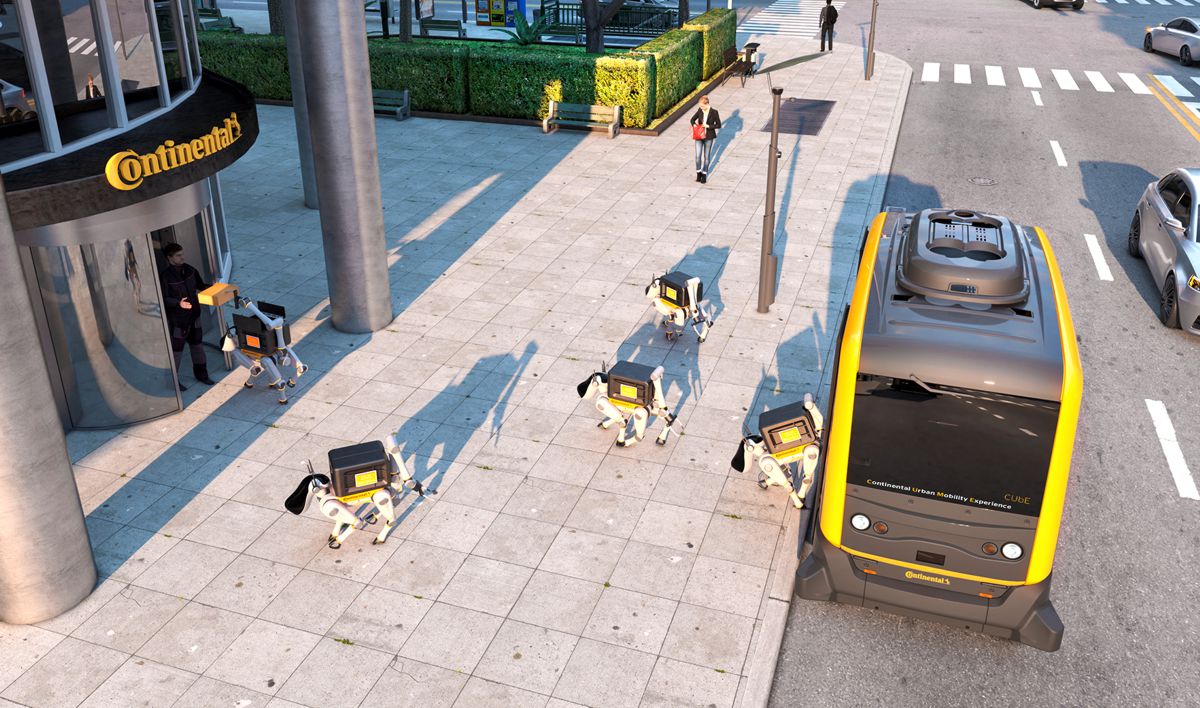Continental’s vision combines autonomous shuttles and delivery robots
The technology company Continental steadily pushes the boundaries of autonomous vehicle technology, exploring new use cases and advancements every day. At CES 2019, Continental will exhibit how a autonomous shuttles could be used to stage and deploy delivery robots, taking packages all the way to the consumer – even when they’re not able to physically receive them.
The seamless integration of a driverless vehicle – in this case, the Continental Urban Mobility Experience (CUbE) – and a delivery robot present a more effective and efficient distribution of goods. The CUbE, Continental’s autonomous electrified development platform, is generally considered as a solution for urban “first or last mile” mobility. This type of vehicle – often referred to as a robo-taxi or pod – will be a part of the seamless mobility value chain.
The purpose of these vehicles will be extended to goods delivery to further utilise the available transport capacity and reduce idle times. Market estimations show that the need to transport goods will even outpace the strongly growing need for people transport in densely populated areas. With expertise in scalable technologies and solutions like sensors, environment perception and modelling, localisation, positioning, situation analysis, decision making and mechatronic actuators, Continental has the solutions and know-how to address this need.
“With the help of robot delivery, Continental’s vision for seamless mobility can extend right to your doorstep. Our vision of cascaded robot delivery leverages a driverless vehicle to carry delivery robots, creating an efficient transport team,” said Ralph Lauxmann, Head of Systems & Technology, Chassis & Safety division, Continental. “Both are electrified, both are autonomous and, in principle, both can be based on the same scalable technology portfolio. These connections create an exciting potential for holistic delivery concepts using similar solutions for different platforms. Beyond this technology foundation, it’s reasonable to expect a whole value chain to develop in this area.”

Urban delivery can use synergies from automated driving
Goods and parcel delivery to residential areas is a growing and dynamic market, driven by e-commerce sales that are increasing every year. With the growth of this segment, delivery cost per hour is gaining importance. This positions last mile and delivery services as a differentiator. Automated goods delivery is forecasted to provide an answer for up to 80 percent of all business-to-consumer deliveries, according to multiple research sources.
Continental views automated goods delivery as an integral part of future urban mobility as an addition to conventional goods delivery. The CUbE can carry one or multiple delivery robots and deploy them to handle the last yards of the goods and parcel delivery logistics chain. “Industrialising the automation of goods delivery requires reliable, robust, high-performing and best-cost technology – a mix perfectly reflected in the automotive equivalent of automation. It is this very profile of expertise that has made Continental one of the industry-leading suppliers of advanced driver assistance systems and vehicle automation,” Lauxmann said.
With existing delivery robots serving as a development platform, Continental is ready to transfer and scale automotive technology to meet robot manufacturers’ requirements. “The challenges to a delivery robot parallel what we already solve for in automated vehicles,” said Jeremy McClain, Director of Systems & Technology, Continental North America. “Plus, delivery robots will require technology that is just as advanced and robust as our automotive solutions.” With the ever-increasing popularity of online shopping and the growth of megacities, unique solutions for package delivery will be needed. Driverless vehicles combined with delivery robots could be the perfect answer.

Seamless Mobility for Smart Cities
Driverless vehicles will represent a very important element in the Smart Cities of the future. They are considered by many experts as a key element of future mobility concepts to solve the challenges of the urbanisation. A driverless vehicle can be in use almost 24/7. Innovative city planners see driverless vehicles as a valuable addition to public mass transport by eliminating the need for a privately owned car to get to the nearest point of access to other means of transport.
“There will be peaks in demand for driverless vehicles during the day. To make use of driverless vehicles outside those peak ‘rush’ hours is where robot-delivery comes in,” said McClain. “We see great potential in our automotive technology to support robotics companies in developing autonomous delivery robots as an additional use case for driverless vehicles.”
Since many deliveries are made during the day, when many people are working, at school or otherwise occupied, the robo-taxi’s off-peak hours could be perfectly utilised for such delivery trips when combined with delivery robots such as this.
At Continental’s booth (North Hall, Booth 7519) during CES 2019 in Las Vegas, the company will demonstrate this use case, pairing an autonomous shuttle with a delivery robot in a residential setting.
Continental develops pioneering technologies and services for sustainable and connected mobility of people and their goods. Founded in 1871, the technology company offers safe, efficient, intelligent and affordable solutions for vehicles, machines, traffic and transport. In 2017, Continental generated sales of €44 billion and currently employs more than 244,000 people in 61 countries and markets.
The Chassis & Safety division develops and produces integrated active and passive driving safety technologies as well as products that support vehicle dynamics. The product portfolio ranges from electronic and hydraulic brake and chassis control systems to sensors, advanced driver assistance systems, airbag electronics and sensorics as well as electronic air suspension systems all the way to windscreen washer systems and headlight cleaning nozzles.
The focus lies on a high level of system competence and the networking of individual components. Thus products and system functions are developed along the SensePlanAct chain of effects. They form the foundation for automated driving. Chassis & Safety employs more than 47,700 people worldwide and generated sales of approximately €9.8 billion in 2017.




















